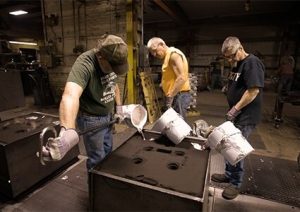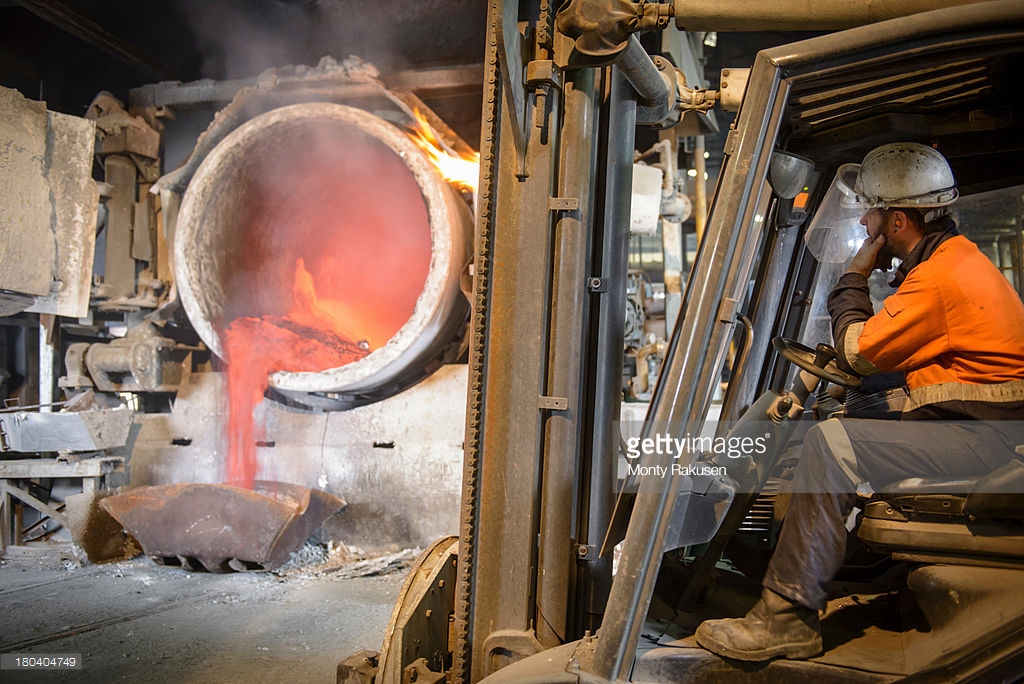Choosing the Right Aluminum Foundry for Your Business Needs
Wiki Article
Checking Out the Cutting-edge Methods Utilized in Modern Aluminum Foundries
Modern aluminum foundries are undergoing a considerable transformation through the fostering of innovative techniques. Advanced casting methods, wise automation, and lasting techniques are improving production procedures. These advancements not only boost effectiveness but also address environmental concerns. As the sector evolves, the combination of digital innovations plays a vital role. Understanding these modifications is crucial for comprehending the future of aluminum manufacturing and its effects for worldwide markets. What lies ahead in this dynamic industry?Advanced Casting Techniques

Additionally, developments in thermal control and mold and mildew design have added to even more constant casting results. These advancements allow for much better control of cooling down rates, minimizing issues and improving mechanical residential properties. As an outcome, producers can create light-weight yet long lasting parts, meeting the enhancing needs of numerous markets, consisting of automobile and aerospace, for high-performance aluminum components.
Smart Automation and Robotics
The integration of wise automation and robotics in aluminum foundries marks a significant innovation in making efficiency. These modern technologies enable precision and consistency in production processes, dramatically lowering human mistake and improving safety and security. Automated robotic systems manage repeated tasks, such as molding, putting, and air conditioning, permitting human drivers to focus on even more complex responsibilities that require vital reasoning and oversight.Furthermore, smart sensing units and AI-driven analytics provide real-time information surveillance, helping with predictive upkeep and reducing downtime. This brings about maximized source allocation and boosted energy intake, contributing to general sustainability in production.
The adaptability of robotic systems permits for quick changes to transforming manufacturing demands, boosting adaptability in production. As foundries progressively embrace these advanced technologies, they not just improve functional performance but likewise position themselves as leaders in technology within the steel casting sector.
Additive Production in Foundries
Changing typical production methods, additive production is transforming aluminum foundries by enabling the production of complex geometries that were previously unattainable. This method enables for the layer-by-layer construction of elements, considerably reducing material waste and reducing production times. As a result, foundries can create detailed layouts that improve efficiency and performance, dealing with the expanding demands of various sectors.Additive production promotes rapid prototyping, permitting engineers to examine and iterate styles swiftly. This agility not only increases the development cycle however also helps in identifying potential concerns prior to full-scale manufacturing starts. The assimilation of innovative products and processes in additive production additionally enhances the mechanical residential or commercial properties of aluminum components, advertising technology in item design. Aluminum foundries that adopt these methods position themselves at the leading edge of sector advancements, making certain competition in an ever-evolving market landscape.
Lasting Practices and Recycling
Sustainable methods in aluminum foundries are increasingly concentrated on enhancing recycling processes and taking on environmentally friendly casting techniques. These developments intend to minimize waste and power consumption while maximizing making use of recycled materials. As the market progresses, the assimilation of sustainability into manufacturing approaches ends up being important for satisfying environmental requirements and customer demands.Recycling Process Improvements
As markets significantly acknowledge the ecological impact of waste, aluminum foundries are embracing ingenious recycling procedure enhancements to improve sustainability. These innovations concentrate on minimizing energy usage and making best use of material healing. For example, lots of foundries are implementing closed-loop systems that reuse scrap aluminum produced throughout manufacturing, minimizing waste and lowering the requirement for virgin materials. Advanced arranging innovations, such as computerized optical sorting, enhance the separation of different aluminum qualities, enhancing the efficiency of the reusing procedure. Additionally, some foundries are using hydrometallurgical methods to recoup aluminum from complicated waste streams. By integrating these renovations, aluminum foundries not only add to a round economy but also lower their carbon impact, straightening with worldwide sustainability goals.Eco-Friendly Casting Techniques
While conventional casting techniques typically entail substantial energy consumption and product waste, aluminum foundries are increasingly adopting green casting strategies that prioritize sustainability. Strategies such as low-pressure die casting, which minimizes air emissions, and making use of water-based mold releases add to reduced ecological effect. In addition, improvements in 3D printing innovation permit for the creation of complex mold and mildews with much less product waste. Several foundries are likewise carrying out closed-loop systems that recycle water and aluminum scrap, more decreasing source consumption. By embracing renewable resource resources, such as solar and wind power, these centers improve their sustainability initiatives. In general, the fostering of environment-friendly methods in aluminum casting not just benefits the setting yet additionally promotes economic performance and advancement within the market.Boosted Quality Assurance Procedures
Boosted quality assurance steps in aluminum foundries are significantly reliant on advanced inspection innovations and real-time monitoring systems. These developments make it possible for suppliers to spot flaws early and ensure constant product quality. By integrating these devices, foundries can considerably boost their functional effectiveness and minimize waste.Advanced Examination Technologies
Advanced assessment modern technologies play a necessary duty in making certain the top quality and integrity of aluminum spreadings. These advanced approaches include non-destructive testing (NDT) strategies such as ultrasonic testing, radiographic testing, and eddy current inspections. Each method permits comprehensive evaluation of castings without endangering their structural stability. Advanced imaging strategies, such helpful site as computed tomography, offer a comprehensive view of internal features, allowing the discovery of defects like spaces and incorporations. Additionally, automated optical evaluation systems improve accuracy by utilizing high-resolution cams and artificial intelligence algorithms to evaluate surface area top quality. By executing these advanced examination technologies, aluminum foundries can properly lessen issues, making certain that spreadings satisfy rigorous industry requirements and client demands.Real-Time Monitoring Solutions
As producers endeavor for excellence in aluminum casting, real-time surveillance systems arise as a pivotal improvement in quality assurance actions. These systems make use of advanced sensing units and data analytics to constantly track important criteria throughout the casting procedure, such as stress, temperature, and alloy composition. By offering instant feedback, they enable drivers to determine deviations from perfect problems and make punctual adjustments. This aggressive approach not just lessens issues but likewise enhances total effectiveness and decreases waste - Wisconsin Aluminum Foundry. Additionally, combination of real-time information right into manufacturing administration systems helps with much better decision-making and improves traceability. Subsequently, real-time tracking systems play a necessary function in maintaining high criteria of top quality in modern-day aluminum foundries, making sure that items fulfill strict market specificationsDigital Double Technology for Optimization

The assimilation of electronic twin innovation allows foundries to check different scenarios without disrupting actual manufacturing. This capability fosters an aggressive method to upkeep and resource administration, inevitably minimizing waste and decreasing operational prices. Additionally, the modern technology aids in process optimization by enabling designers to picture the results of adjustments in real-time, making sure better outcomes. As an outcome, aluminum foundries taking on digital twin innovation are placed to achieve better effectiveness and competition in a progressively demanding market.

Sector 4.0 and IoT Combination
The adoption of electronic twin modern technology in aluminum foundries is component of a broader movement towards Industry 4.0, characterized by the assimilation of the Net of Things (IoT) right into making processes. This integration allows real-time tracking and data collection from various machinery and devices, resulting in boosted Aluminum Castings functional performance. Sensors embedded in devices gather critical data, which is evaluated to enhance manufacturing operations and anticipate maintenance requirements.Furthermore, IoT devices help with communication between various production phases, permitting seamless control and lessening downtime. By leveraging cloud computer, foundries can keep and evaluate large amounts of information, allowing more enlightened decision-making. This innovation likewise sustains remote administration, where operators can manage procedures from anywhere, boosting responsiveness to manufacturing obstacles. Overall, the fusion of Sector 4.0 and IoT within aluminum foundries is changing standard methods, making them more dexterous and responsive to market demands.
Frequently Asked Questions
adviceWhat Are the Main Advantages of Aluminum Over Other Steels?
Aluminum provides many advantages over other metals, including its lightweight nature, excellent deterioration resistance, high thermal and electric conductivity, pliability, and recyclability, making it a recommended option for various applications across several industries. - Aluminum FoundryJust How Do Modern Foundries Deal With Hazardous Products?
Modern foundries handle dangerous products through strict safety and security procedures, progressed filtering systems, and recycling approaches. Regular training assurances employees understand finest techniques, while keeping track of systems detect and reduce possible risks to preserve a risk-free workplace.What Is the Typical Lifespan of Aluminum Castings?
The common life expectancy of aluminum spreadings ranges from 20 to half a century, depending on elements such as ecological problems, use, and upkeep. Proper care can extend their durability and efficiency considerably gradually.Are There Any Health Threats Associated With Aluminum Foundry Job?
Yes, aluminum factory work presents health and wellness threats, including respiratory system issues from inhaling fumes and dust, skin inflammation from contact with molten metal, and potential direct exposure to hazardous chemicals. Correct safety and security actions are necessary to minimize these dangers.Just How Do Factories Make Sure Employee Safety And Security in High-Temperature Environments?
Shops apply rigorous safety and security methods, including safety gear, temperature surveillance systems, and normal training. These measures guarantee that workers are equipped to deal with high-temperature atmospheres, reducing risks and advertising a much safer work environment.
Countless innovative casting techniques have actually emerged in aluminum foundries, revolutionizing conventional procedures. Sustainable techniques in aluminum foundries are progressively concentrated on improving recycling procedures and embracing green casting strategies. Several foundries are executing closed-loop systems that recycle scrap aluminum produced during manufacturing, lessening waste and reducing the requirement for virgin materials. While conventional casting techniques usually include significant energy usage and product waste, aluminum foundries are increasingly embracing green casting techniques that focus on sustainability. While many sectors are significantly taking on electronic modern technologies, aluminum foundries are leveraging digital twin technology to boost functional performance and enhance production processes.
Report this wiki page